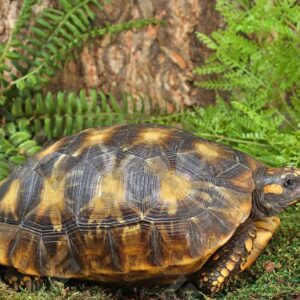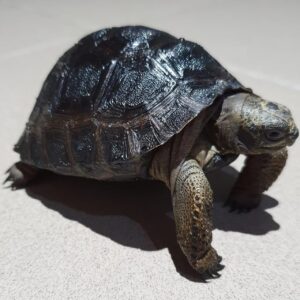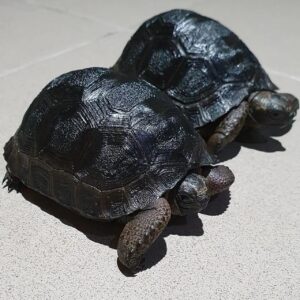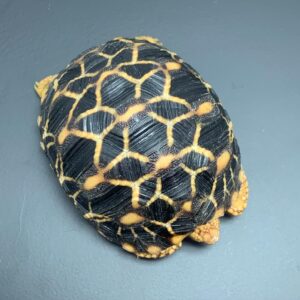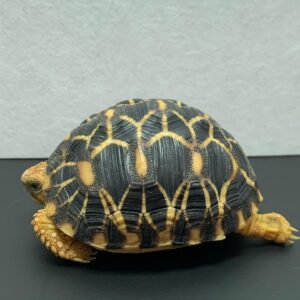Giant Hermanns Tortoise Trio For Sale
$899.99
WE HAVE A GIANT HERMANNS TORTOISE TRIO #1 FOR SALE. HERE ARE SOME HIGHLIGHTS:
- Testudo hermanni
- Farm Bred
- Male Is Approximately 8 Inches In Total Shell Length
- Female #1 Is Approximately 7 Inches In Total Shell Length
- Female #2 Is Approximately 7 Inches In Total Shell Length
- As Adults These Can Grow Up To 7 – 9 Inches In Shell Length
- Feeding On Mixed Greens, Various Vegetables, And Mazuri Tortoise Diet Regularly
Description
The Giant Hermanns Tortoise, scientifically known as Testudo hermanni, is a remarkable species that has captivated the attention of both conservationists and reptile enthusiasts. This tortoise distinguishes itself through its notable physical characteristics and unique natural habitat. Typically, the Giant Hermann’s Tortoise has a domed carapace that exhibits a striking pattern of yellow and black. The shell can grow up to 30 centimeters in length, making it larger than many of its close relatives. Additionally, it possesses robust, scaly limbs and a beak-like mouth suited for its herbivorous diet.
This species inhabits the Mediterranean forests, scrublands, and rocky hillsides, predominantly found in regions such as southern Europe, including Spain, France, Italy, and the Balkans. The preferred environment provides ample opportunities for foraging on a diet rich in grasses, herbs, and fruits. The Giant Hermann’s Tortoise is well-adapted to these environments, capable of withstanding the seasonal variations that characterize the Mediterranean climate.
The significance of the Giant Hermanns Tortoise extends beyond its physical attributes and habitat preferences. This species plays a crucial role in its ecosystem, contributing to the maintenance of vegetation and serving as an indicator of environmental health. Its presence signifies a well-balanced and biodiverse habitat, making it an essential focus for conservation efforts. The tortoise is currently listed as near threatened due to habitat loss, illegal pet trade, and other anthropogenic pressures. As such, it has become a symbol of conservation efforts aimed at preserving not only the species itself but also the broader ecological systems to which it belongs.
Understanding the Giant Hermanns Tortoise is pivotal for both scientific research and conservation strategies. It offers insights into the complex interplay between species and their environments, emphasizing the importance of preserving natural habitats and mitigating human impacts. Thus, the Giant Hermann’s Tortoise continues to be a subject of profound interest and study within the reptile world.
Habitat and Distribution
The Giant Hermanns Tortoise, a remarkable species, thrives in diverse habitats across specific regions. Primarily found in the Mediterranean Basin, these tortoises inhabit areas stretching from southeastern France to western Turkey, including parts of Italy and the Balkans. Their preferred environments vary, but they predominantly reside in woodlands, scrublands, and rocky hillsides. These habitats provide the necessary cover and food resources essential for their survival.
Woodlands offer a rich array of vegetation, which forms a crucial part of the Giant Hermanns Tortoise’s diet. These areas are typically composed of deciduous and evergreen trees, providing ample shade and protection from predators. Scrublands, characterized by dense, low-lying shrubbery, present an ideal environment for these tortoises due to the abundance of herbaceous plants and the relative ease of burrowing.
Rocky hillsides, another common habitat, afford the Giant Hermanns Tortoise excellent opportunities for basking, a behavior critical for thermoregulation. The rocky terrain also offers numerous crevices and shelters, which are vital for protection and nesting. The diversity in vegetation across these habitats ensures a varied diet, consisting mainly of grasses, herbs, and occasionally fruits.
The climatic conditions of these regions significantly influence the behavior and lifestyle of the Giant Hermanns Tortoise. The Mediterranean climate, characterized by hot, dry summers and mild, wet winters, dictates their activity patterns. During the warmer months, these tortoises are most active in the early morning and late afternoon to avoid the midday heat. In contrast, the cooler winter months see a reduction in their activity levels as they enter a state of brumation, a hibernation-like condition.
Understanding the habitat and distribution of the Giant Hermanns Tortoise is essential for conservation efforts. Protecting these natural environments ensures the survival of this species, allowing future generations to observe and study these fascinating creatures in their native settings.
Physical Characteristics and Behavior
The Giant Hermanns Tortoise is a remarkable species, known for its distinctive physical characteristics and intriguing behavior. These tortoises are notably larger than their standard counterparts, with adults typically reaching lengths of up to 30 centimeters and weighing between 3 to 5 kilograms. Their domed shells exhibit a stunning array of colors, predominantly featuring shades of yellow and brown with intricate black markings that provide effective camouflage in their natural habitat.
One of the most distinguishing features of the Giant Hermanns Tortoise is its robust and hardy shell, which serves as both protection and a means of temperature regulation. The shell is composed of a series of scutes, or bony plates, that are durable and aid in defending against predators. Additionally, the tortoise’s limbs are well-adapted for both digging and traversing rocky terrains, thanks to their strong, clawed feet.
In terms of behavior, the Giant Hermanns Tortoise exhibits a range of fascinating patterns. These tortoises are primarily herbivorous, with a diet consisting mainly of grasses, leaves, flowers, and fruits. They have a keen sense of smell that aids in foraging for food. Socially, they are generally solitary creatures, though they can be seen interacting during mating seasons or when resources are abundant. Despite their solitary nature, they exhibit a unique form of communication through head bobbing and other gestures.
Daily routines of the Giant Hermanns Tortoise are largely influenced by the climate. They are diurnal, meaning they are active during the day and rest at night. During the hotter parts of the day, they often seek shade or burrow to avoid overheating. The tortoises are also known for their remarkable longevity, with some individuals living for over 50 years, making them one of the more enduring species in the reptile kingdom.
Diet and Nutrition
The Giant Hermanns Tortoise, a subspecies of the Testudo hermanni, thrives on a diet that closely mimics its natural habitat’s offerings. In the wild, these tortoises primarily consume a variety of plant materials, including leaves, flowers, and fruits. Their diet is predominantly herbivorous, with a strong preference for fibrous plants that aid in their digestion. Natural vegetation such as dandelions, clover, and various grasses forms the cornerstone of their nutritional intake.
In captivity, it is crucial to replicate this diet as closely as possible to ensure the health and longevity of the Giant Hermanns Tortoise. Owners should provide a diverse array of leafy greens, such as kale, collard greens, and turnip greens, while avoiding spinach and other oxalate-rich foods that can inhibit calcium absorption. Seasonal fruits like berries and melons can be offered in moderation, but they should not constitute the bulk of the diet due to their high sugar content.
To meet the tortoise’s nutritional requirements, it is essential to include calcium-rich foods and possibly supplement with a calcium powder, especially for indoor tortoises that may not get ample sunlight for natural Vitamin D3 synthesis. Cuttlefish bone can also be offered as a calcium source and helps in beak maintenance.
Feeding frequency for the Giant Hermanns Tortoise should be regular but not excessive. Younger tortoises may require daily feeding, while adults can be fed every other day. Fresh water should always be available, although tortoises obtain much of their hydration from their food. Additionally, providing a shallow water dish for soaking can aid in hydration and help maintain skin health.
Foraging opportunities should be encouraged to promote natural behaviors and physical activity. Scatter food around their enclosure to mimic the foraging process they would experience in the wild. Avoid commercial pet foods, which often contain unsuitable ingredients and lack the nutritional balance needed for a Giant Hermanns Tortoise.
Reproduction and Lifespan
The reproductive cycle of the Giant Hermanns Tortoise is a captivating aspect of its biology, showcasing both intricate behaviors and remarkable longevity. Mating behaviors typically commence in the spring, spurred by warmer temperatures and increased daylight. Male tortoises exhibit a range of courtship behaviors, including head bobbing, chasing, and biting. These actions are not merely aggressive displays but rather essential components of their mating rituals that ensure the propagation of the species.
Nesting habits of the Giant Hermann’s Tortoise are equally fascinating. Females seek out specific locations with loose, sandy soil to dig nests—a process that can take several hours. The nests are typically located in well-drained, sunlit areas to optimize the incubation conditions. After laying a clutch of 2 to 12 eggs, the female covers the nest with soil, effectively camouflaging it from predators. The incubation period varies but generally lasts between 90 to 120 days, depending on environmental factors such as temperature and humidity.
The lifespan of the Giant Hermann’s Tortoise is impressive, often exceeding 50 years in the wild, with some individuals living well into their 70s or 80s. Several factors contribute to their longevity. A slow metabolism and a herbivorous diet rich in fibrous plants help in maintaining their health. Additionally, their robust shell offers protection from many predators, thereby reducing mortality rates. However, human activities such as habitat destruction and illegal pet trade pose significant threats to their populations. Conservation efforts are thus crucial in ensuring their continued survival.
Understanding the reproductive cycle and lifespan of the Giant Hermann’s Tortoise not only enriches our knowledge of this remarkable species but also underscores the importance of conservation efforts aimed at protecting their natural habitats and ensuring their long-term survival.
Conservation Status and Threats
The Giant Hermanns Tortoise, a remarkable species, is currently classified as “Near Threatened” on the International Union for Conservation of Nature (IUCN) Red List. This status underscores the pressing need for conservation measures to ensure the survival of this unique tortoise species. Several factors contribute to the precarious position of the Giant Hermann’s Tortoise in the wild.
One of the primary threats to the Giant Hermanns Tortoise is habitat destruction. Urbanization, agricultural expansion, and deforestation are leading to the fragmentation and loss of their natural habitats. As human activities encroach upon these territories, the tortoises are left with limited space to thrive and reproduce, thus jeopardizing their population.
Poaching and illegal pet trade also pose significant risks to the Giant Hermanns Tortoise. Despite legal protections in many regions, the allure of these tortoises as exotic pets drives illegal capture and trade. This not only reduces their numbers in the wild but also disrupts the natural balance of their ecosystems.
Climate change further exacerbates the challenges faced by the Giant Hermanns Tortoise. Altered weather patterns, increased temperatures, and changing vegetation impact their food sources and nesting sites. These environmental changes can lead to reduced reproductive success and higher mortality rates, putting additional strain on the species’ survival.
In response to these threats, various conservation efforts are underway to protect and preserve the Giant Hermanns Tortoise. Conservation organizations and governmental bodies are working together to establish protected areas, implement anti-poaching measures, and conduct breeding programs. Education and awareness campaigns are also crucial in reducing demand for illegal pet trade and fostering community support for tortoise conservation.
By addressing the threats of habitat destruction, poaching, and climate change, and through the concerted efforts of conservation initiatives, there is hope for the continued existence of the Giant Hermanns Tortoise in the wild. Ensuring their survival requires ongoing dedication and collaboration from all stakeholders involved.
Caring for Giant Hermann’s Tortoises in Captivity
Giant Hermanns Tortoises can make fascinating pets, but their care requires meticulous attention to detail. Proper habitat setup is crucial to mimic their natural environment and ensure their well-being. The enclosure should be spacious, allowing ample room for movement; a minimum of 8×4 feet is recommended for adults. Outdoor enclosures are ideal, offering natural sunlight and fresh air, but indoor setups can also be managed with the right equipment.
Temperature regulation is vital for the health of Giant Hermanns Tortoises. Daytime temperatures should range between 75-85°F, with a basking spot reaching 90-95°F. Nighttime temperatures can drop to around 65-70°F. Use a combination of heat lamps and ceramic heat emitters to maintain these conditions. Lighting is equally important; UVB lighting is essential for calcium absorption and shell health. Ensure that UVB bulbs are replaced every 6-12 months, as their effectiveness diminishes over time.
The diet of Giant Hermanns Tortoises should closely resemble their natural diet. A variety of leafy greens, such as dandelion greens, collard greens, and mustard greens, should form the bulk of their diet. Occasional fruits can be offered, but they should be limited to avoid excessive sugar intake. Calcium and vitamin supplements are also necessary to prevent deficiencies; provide a cuttlebone or a calcium block in the enclosure.
Regular health care and general maintenance are imperative. Monitor your tortoise for signs of illness, such as lethargy, lack of appetite, or respiratory issues. Maintain cleanliness in the enclosure to prevent bacterial infections; spot-clean daily and perform a thorough cleaning weekly. Regular veterinary check-ups are recommended to catch any potential health issues early.
By paying close attention to these care guidelines, owners can ensure their Giant Hermann’s Tortoises thrive in captivity, leading healthy and fulfilling lives.
Interesting Facts and Myths
The Giant Hermanns Tortoise, known for its impressive size and longevity, is a subject of many interesting facts and myths. One of the most captivating aspects of this tortoise is its remarkable lifespan. These tortoises can live well over 50 years, with some even reaching a century. This longevity is often attributed to their slow metabolism and careful diet, which primarily consists of a variety of plant material.
Contrary to popular belief, the Giant Hermann’s Tortoise is not a giant in the conventional sense. While larger than its cousins, it is still modest in size compared to true giants like the Galápagos tortoise. Adult Giant Hermann’s Tortoises typically range from 11 to 14 inches in length, making them manageable for both conservationists and pet enthusiasts.
Historically, the Giant Hermanns Tortoise has been a part of various cultural narratives. In ancient Rome, these tortoises were often kept as pets, symbolizing long life and stability. The myth of tortoises carrying the world on their backs also finds roots in many cultures, though it is more commonly associated with other tortoise species.
One prevalent myth is that tortoises can survive indefinitely without water. While they are incredibly resilient and capable of withstanding arid conditions, access to clean water is essential for their health. Dehydration can lead to severe health issues, debunking the myth of their invincibility to drought.
Another interesting fact about the Giant Hermanns Tortoise is its unique shell pattern. The carapace features distinct, brightly colored markings that not only make them visually striking but also help in identifying individual tortoises. These patterns play a crucial role in studies related to their behavior and ecology.
In summary, the Giant Hermann’s Tortoise is a fascinating creature surrounded by a mix of intriguing facts and enduring myths. Understanding its characteristics and dispelling misconceptions enhances our appreciation and ability to conserve this incredible species.







